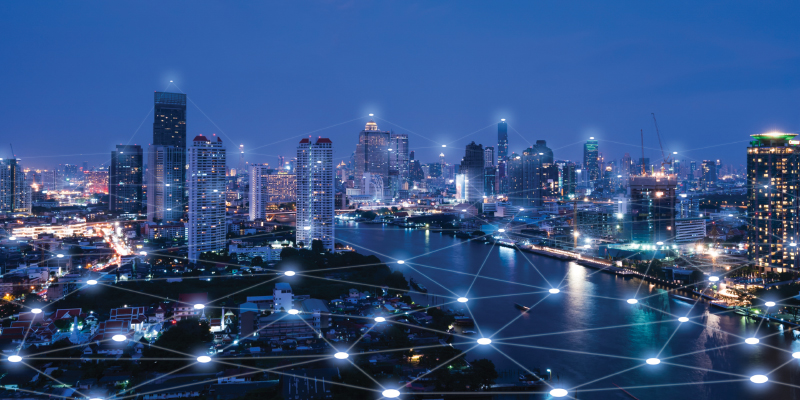If it’s around long enough, every industry experiences change and disruption. The utility industry is no exception. When compared to other sectors of the economy, it may actually be experiencing a disproportionate amount of change driven by a wide range of factors — environmental, societal and technological. The primary paradigm shifts that are the source of disruption tend to fall into four different categories:
- Grid modernization
- Environmental, Social and Governance reporting (ESG)
- Preparation for electric vehicle growth
- Battery storage to empower grid flexibility
But there are two additional areas that don’t get a lot of attention, the growth of smart cities and the role of edge computing. There is certainly overlap amongst all of these areas in terms of the challenges and opportunities they represent. You could also argue that the promise and phenomenon of smart cities and edge computing have a direct impact on each of these other areas as enabling solutions to help overcome some of the headwinds the industry is facing. To understand the roles of smart cities and edge computing, it may be helpful to take a quick look at the other foundational challenges that they can help solve.

Figure 1 The modern grid’s objective pivots towards the consumer empowering consumers to adjust their energy consumption, with dynamic pricing models that reflect real-time energy costs.
Grid modernization
The power grid stands as the backbone of our modern society. Yet, with time, signs of wear and tear are becoming evident. Aging infrastructure, stretched resources and rising cyber threats highlight vulnerabilities. Additionally, there’s an urgent need to assimilate renewable energy sources and update the early-2000s first-generation “smart” meters that are nearing the end of their operational lives.
Addressing these challenges begins with the adoption of advanced metering infrastructure (AMI). The next generation of smart meters, integral to AMI, function as edge computing devices. These advanced meters offer real-time, actionable intelligence, enabling utilities to enhance efficiency, sustainability and profitability.
Historically, grids in the early 20th century were tailored for a one-way power flow — centralized energy plants channeled power to the consumers. However, the narrative is changing. The move towards decentralized systems, coupled with renewable energy sources and microgrids, showcases a pivotal transformation. We’re transitioning from a simple one-way power delivery mechanism to intricate two-way power flow systems.
Digital transformation is revolutionizing the utility sector. As AI-driven solutions streamline operations, IoT devices enable precise monitoring, while blockchain promises transparent, tamper-proof energy transactions. The modern grid’s objective pivots towards the consumer. Now, dynamic pricing models reflect real-time energy costs, empowering consumers to adjust their energy consumption. The grid’s bolstered reliability means blackouts are increasingly rare. Moreover, the rise of "prosumers" — consumers who can sell their surplus solar energy back to the grid — demonstrates a vibrant, evolving energy ecosystem.
Environmental, social and governance (ESG)
In the contemporary world, a company’s commitment to environmental and societal values is not just a moral obligation but also a crucial aspect of its public persona. The lens of scrutiny, particularly on publicly traded companies, has been sharpening. Stakeholders and regulators are now more alert than ever, especially concerning decarbonization efforts. However, the narrative of sustainability and global warming’s implications has been so deeply woven into our societal fabric that the focus has expanded. It’s not just the major corporations under the limelight; government entities and private sectors are also being observed and evaluated.
Solutions lie in technological and operational advancements. Grid modernization, advanced metering intelligence, the integration of renewable energy sources and battery storage are instrumental. They don’t merely serve as technological upgrades but as tools to help both public and private sectors navigate ESG complexities. These innovations usher in operational efficiency and a shift towards more environmentally friendly solutions.
The evolution in utilities is also visible in their approach to societal responsibilities. There’s a surge in initiatives like community solar programs, employment opportunities in the renewable sectors and efforts to tackle energy poverty. The aim is clear: to ensure universal access to consistent and reliable power.
Yet, these efforts must be underpinned by robust governance structures. It’s not just about regulatory adherence but fostering a culture where the broader ESG vision cascades from leadership, permeating every organizational level and ensuring holistic alignment.
Electric vehicle growth
The trajectory of electric vehicles (EVs) is soaring, presenting both opportunities and challenges for utilities. As EV adoption accelerates, utilities confront the dual task of assimilating them into the power infrastructure while also catering to their rising electricity demand. The potential of EVs goes beyond just an environmental footprint reduction. Indeed, they spearhead the march towards a net-zero emissions world. However, this rise is not without its implications; it exponentially strains our electricity infrastructure. The strain is evident in two primary areas: the need for domestic charging solutions and the expansive development of public charging networks.
To navigate these challenges, the technological prowess of edge computing becomes invaluable. Especially when paired with tools like smart meters and Advanced Metering Infrastructure (AMI), they become pivotal in effectively managing the grid’s demand and load balance.
The impact of EVs isn’t just limited to roads or charging stations. It’s reshaping urban landscapes. Urban planners, in tandem with architects, are now drafting the future blueprints of cities with a clear EV focus. This includes dedicated EV lanes on roads, widespread public charging infrastructure and ensuring new building codes are EV-ready.
As EVs continue to dominate, we witness a parallel decline in the conventional petroleum-driven transport model. This changing dynamic signals a clarion call for the oil and gas sectors. Adaptation is the key, whether that’s through diversifying their portfolios, ramping up investments in renewable energy, or pivoting to produce components vital for the EV industry.
Battery storage
When delving into the intricacies of the energy landscape, the pivotal role of battery storage becomes unmistakably clear. This is accentuated as renewable energy sources, particularly wind and solar, claim a larger stake in the power grid. Their adoption not only underscores the pursuit of sustainability but also amplifies the importance of battery storage. The reasons are twofold: the unpredictable nature of renewables and the increased frequency of extreme climatic events. In such a scenario, battery storage acts as the bulwark, ensuring a resilient energy infrastructure and safeguarding against potential power disruptions.

Figure 2 The impact of EVs is reshaping urban landscapes, changing how urban planners and architects draft future blueprints of cities with a clear EV focus.
Legislative strides, especially in regions like the U.S. and Europe, further bolster the case for battery storage. Recent legislations, aimed at fueling energy innovations, have earmarked substantial incentives. These are designed to boost the integration and utilization of battery storage within the broader energy ecosystem.
The spectrum of battery technology is both wide and evolving. While lithium-ion batteries currently lead the pack in efficiency, the horizon shows promise with contenders like solid-state batteries, known for their extended lifespan and heightened safety parameters. Additionally, ongoing research in areas like graphene and flow batteries heralds a new era in storage potential.
On a more granular level, residential energy solutions like Tesla’s Powerwall are redefining the domestic energy narrative. These systems enable homes to harness and store solar energy for nocturnal usage, inching closer to the reality of off-grid living. For the corporate sector, the appeal of battery storage lies in the promise of unwavering power — an essential for operations that can’t afford interruptions.

Figure 3 Smart cities are urban hubs with intricate webs of connectivity, providing residents with a higher quality of life.
Smart cities
One of the most transformative yet understated shifts in the energy domain is the emergence of smart cities. These aren’t just urban areas focused on better energy management but are intricate webs of connectivity. At the heart of a smart city is the Internet of Things (IoT), interlinking devices, machinery and objects in a vast digital network that seamlessly communicates and exchanges data. This network serves as a lynchpin for municipalities, offering a bird’s-eye view of traffic, waste management, public transportation and a plethora of other services.
The real magic, however, lies in the data analytics. By processing real-time data, smart cities optimize decision-making processes, enhancing both their speed and accuracy. The ripple effect of this is profound: residents enjoy a higher quality of life, sustainability goals are accelerated and resources are judiciously allocated.
Powering this intricate urban tapestry are foundational devices like smart meters and innovations in edge computing. These elements synergize, forming the robust neural network of the smart city, enabling both its digital and physical entities to function with unparalleled intelligence.
Trailblazing this movement are cities like Barcelona, renowned for its holistic IoT integrations across public services, and Singapore, celebrated for its pioneering smart traffic solutions. These cities not only manifest the potential of smart urban spaces but also spotlight their tangible societal and economic dividends.
However, the dazzling allure of hyper-connectivity does cast a shadow: privacy. The continuous data churn, while invaluable, underscores the paramount importance of robust data protection mechanisms. Ensuring that this data remains inviolable and isn’t misused is a challenge that smart cities must earnestly address.

Figure 4 The future of edge computing will redefine paradigms by using AI algorithms to proactively schedule repairs and manage energy distribution.
Edge computing
Imagine a vast enterprise ecosystem, pulsating and thriving. At its core lies edge computing, akin to a central nervous system, responsive and agile.
In the realm of Advanced Metering Infrastructure (AMI), a prime example of edge computing is the smart meter. This device isn’t merely a gauge of energy consumption. It’s a dynamic tool, gathering, managing and analyzing energy data in real time. Instead of relying on remote servers or vast data centers, edge computing places the computational process right at the source of data generation. This can be any device — from equipment, machinery, sensors and even the aforementioned smart meters.
The beauty of edge computing lies in its immediacy and relevance. Rather than shuttling heaps of data across vast distances to centralized repositories or cloud storage, data is processed on the spot. This proximity enables devices to respond with lightning speed. For instance, machinery equipped with edge computing can identify wear and tear, prompting autonomous preventive shutdowns or notifying personnel with actionable insights. The benefits are multifold: reduced downtime, minimized maintenance costs and enhanced security since data is not aggregated in one vulnerable spot.
Now, imagine the applicability in utilities. Envision a wind turbine, bristling with sensors. The moment an anomaly is detected, edge computing allows for immediate action, like shutting down the turbine and averting potential damages.
The future of edge computing is, undeniably, expansive. It’s set to redefine paradigms, from the way maintenance is predicted — with AI algorithms scheduling proactive repairs — to revolutionizing energy distribution, adjusting it dynamically based on demand and supply fluctuations.
What’s next?
At the intersection of curiosity, ingenuity and experience, there’s a potent drive to address challenges across various industries. The commitment transcends beyond immediate needs, reaching out to our shared global future. Thus, R&D efforts are steered towards holistic solutions — ones that resonate with economic growth and enhance human well-being.
The pursuit of innovation is not merely about introducing new tools or technologies; it’s about crafting solutions that elevate efficiency, resilience, sustainability and profitability. More so, it’s about enhancing the quality of life on a global scale. Whether it’s the intricate networks of smart cities or the rapid advancements in edge computing, the true power lies in connectivity. Every connection paves the way for new opportunities, each more promising than the last.
Navigating the future does come with its set of challenges. The increasing concerns of climate change and resource constraints underline the need for collaborative efforts. It is this spirit of global cooperation, manifested in combined research, technology sharing and cohesive policymaking, that will drive the shift towards sustainable energy frameworks.
Moreover, the energy grid of the future will be more interactive and inclusive. Empowered by innovative platforms, consumers will transition from mere users to informed participants. They’ll possess the capability to monitor energy use, make data-driven decisions and even engage actively in energy trading ecosystems. Such a future, carved by technological innovations and a focus on human-centric approaches, is on the horizon.

Ronald Hermans joined Honeywell through the Elster acquisition and has more than 20 years of experience in the utility and software industries. Hermans has worked in a variety of roles spanning solution and product management, technical sales, marketing and project delivery in EMEA, with customers across all segments of the utility industry, focused on leveraging technology to protect and improve business processes and customer service.







